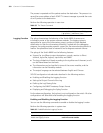
SNMP 323
The current SNMP Agent of Ethernet switch supports SNMP V1, V2C and V3. The
MIBs supported are listed in the following table.
Configuring SNMP Configuring SNMP includes tasks that are described in the following sections:
■ Setting the Community Name
■ Enabling and Disabling the SNMP Agent to Send a Trap
■ Setting the Destination Address of a Trap
■ Setting the Lifetime of the Trap Message
■ Setting SNMP Information
■ Setting the Engine ID of a Local or Remote Device
■ Setting and Deleting an SNMP Group
■ Setting the Source Address of the Trap
■ Adding and Deleting a User to or from an SNMP Group
■ Creating and Updating View Information or Deleting a View
■ Setting the Size of an SNMP Packet Sent or Received by an Agent
■ Enabling and Disabling Transmission of Trap Information
■ Disabling the SNMP Agent
■ Displaying and Debugging SNMP
Setting the Community Name
SNMP v1, and SNMP v2C, and SNMP v3 use the community name authentication
scheme. An SNMP message that does not comply with the community name that
is accepted by the device is discarded. An SNMP community is named with a
character string, which is called the community name. Communities can have
read-only or read-write access modes. A community with read-only authority can
Table 43 MIBs Supported by the Switch 8800
MIB Attribute MIB Content References
Public MIB MIB II based on TCP/IP network
device
RFC1213
BRIDGE MIB RFC1493
RFC2675
RIP MIB RFC1724
RMON MIB RFC2819
Ethernet MIB RFC2665
OSPF MIB RFC1253
IF MIB RFC1573
Private MIB DHCP MIB
QACL MIB
ADBM MIB
RSTP MIB
VLAN MIB
Device management
Interface management


















